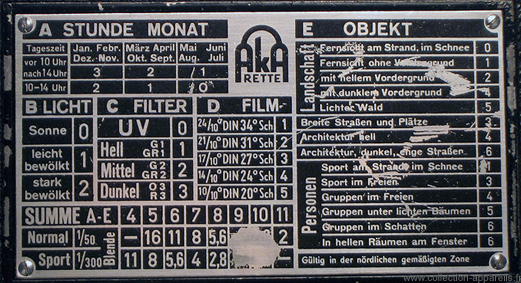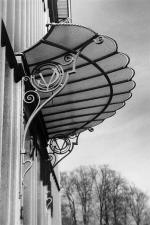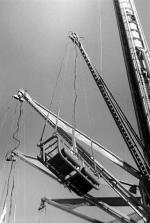|
Aka Akarette II |
Manufactured or assembled in Germany from 1950 to 1954.
Index of rarity in France: Infrequent (among non-specialized garage sales)
Inventory number: 1780
See the complete technical specifications
Chronology of cameras Aka
Although it had a short existence, Aka company produced a significant number of camera models, which share high manufacturing quality. The first series was called Akarette, which was soon accompanied by the Akarelle series. A few years later, a modification in the camera's aesthetics led to the appearance of the Arette series.
The Akarette cameras are small cameras with interchangeable lenses. Their cover has a characteristic bulge because the viewfinder is double, to correspond to two different focal lengths. Their length is indicated on the front face of the two windows. A button allows the photographer to move an obstacle in one of the two parts of the viewfinder so that he can remember the focal length in use. Of course, the photographer must manually move this point when changing lenses.
In 1950, the Akarette II replaced the Akarette I, alongside the Akarette 0. The manufacturing quality remained the same but slightly less luxurious. The black lacquer was replaced by chrome. An accessory shoe appeared above the housing. The small button for blocking one of the two parts of the viewfinder was replaced by a small lever. The shutter used was a Prontor-S, including a self-timer. This self-timer was absent from the cheaper Akarette 0 version.
The lens change on the Akarette might seem puzzling, as it is neither a bayonet mount nor a screw-in lens. There are four rings around the lens barrel. Starting from the camera body, the first ring controls the speed, the third controls the aperture, and the fourth controls the distance. The second ring is unscrewed to release the lens.
Another unique feature is that the frame counter does not advance during winding but only upon shutter release.
On the back of this model (and possibly others), there is a table for calculating the shutter speed/aperture combination.
Table A (Stunde Monat - Hour Month), according to the hour and the month, provides a number.
Table B (Licht - Light) determines a number based on brightness: Sunny, slightly overcast, heavily overcast.
Table C gives a number based on the use of a filter.
Table D gives a number based on the film sensitivity. Finally, Table E provides a new number based on the type of subject being photographed.
You need to add up the five obtained numbers, and the total is to be entered in the Summe A-E (Sum from A to E) table. It gives the aperture value to use for a shutter speed of 1/50 or 1/300.
For example: It's June 15th, and it's 4:00 PM. The weather is sunny, and the camera has a UV filter. The film sensitivity is 21° DIN. The subject is a street scene. The obtained values are: 1, 0, 0, 2, and 3. The sum of these numbers is 6. For a fast shutter speed, set the aperture to f/5.6.



The history of the Aka brand (an acronym for Apparate & Kamerabau) is closely linked to World War II and its aftermath. The brand was founded in 1946 by the Armbuster brothers in the French sector. One of the brothers had skills in camera production, having worked for major German manufacturers of cameras and shutters. The other had a foundry and a tool factory.
Production of a central shutter camera with interchangeable lenses began in an old hotel in Wildbad. This camera was called the Akarette and aimed to be a more affordable competitor to the Leica. The first models produced negatives of 24 x 32 mm, which allowed for more shots per film. However, this was quickly abandoned in favor of the 24 x 36 mm standard. Production gradually increased with the German economy's recovery, requiring larger premises. Unable to find any in Wildbad, the company moved to the shores of Lake Constance, to Friedrichshafen, in the former pilot school. Production started there in April 1949. The range diversified with simpler models than the first Akarette, or more elaborate models with rangefinders.
In 1958, one of the brothers left the company for Feinwerktechnik, while developing a stereo camera compatible with View-Master, whose financing was a source of dispute between the brothers. This departure marked the beginning of the company's decline. Bankruptcy followed in 1960. A new company, Arette Feinwerktechnik GmbH, built cameras until 1963, using the parts still in stock.
Aka cameras are sometimes found at French flea markets. Sellers who know the history of their camera often mention its purchase by a conscript who served in Germany, either in the Black Forest or around Lindau, in the 1950s.
1 As a reminder, the French, American, British, and Soviet sectors were the result of the Yalta agreements that defined a partition of Nazi Germany between the victorious powers. Each occupying force exercised full administration over its sector. In 1949, the creation of the two German states significantly reduced the prerogatives of the four occupying nations. Military presence was maintained until after reunification in 1993.
2 Friedrichshafen is the city of Zeppelin and Dornier airplanes.
(original document in german)
Interesting links or bibliography :
| Sur mes-appareils-photos.fr, suggested by Eric Carlhan |
Add a link or element of bibliography, a picture taken with this camera, a picture of box or an ads about this camera
Your photos taken with the same camera:

| 
|
Cameras from Ebay France (Aka) (Uploaded each 3 hours)








